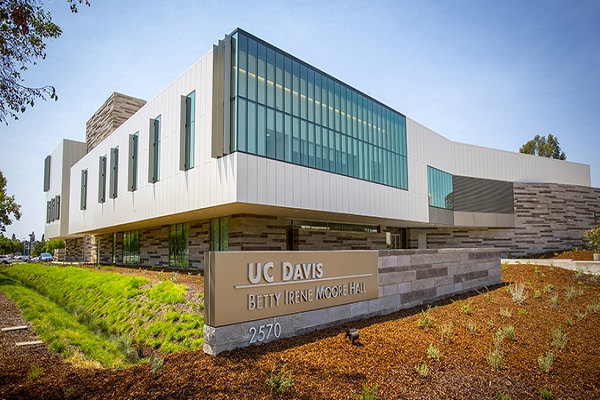University of California, Davis: Engineering Dean Corsi Clears the Air at White House
After Dean Richard Corsi’s recent participation on a panel at the White House, don’t be surprised if you hear the current occupants followed the dean’s lead and built a Corsi-Rosenthal box for cleaner air in their home, like a lot of people have done during the pandemic.
The White House had invited Corsi, a UC Davis alumnus who returned to lead the College of Engineering in September 2021, to address “Innovations in Air Quality,” part of the Biden administration’s Oct. 11 Summit on Improving Indoor Air Quality.
He joined others from academia, business, government, K-12 schools and health care to discuss the importance of indoor air quality for improving the overall health and well-being of society, plus the need for improved policy for integrating better indoor air quality standards into all segments of life.
“For many people this may seem like a narrow topic, indoor air quality, but for people who have been paying attention for the past 2½ years, you all know this is neither a narrow nor a side issue,” said Ashish Jha, a physician who serves as the administration’s COVID-19 response coordinator. “It is absolutely critical if we are going to think about improving public health in America, improving public health in the world.”
Corsi was perfect for his panel, having advocated for policy change and more research on indoor quality for more than 20 years. He spoke about creating innovations that are accessible and low cost.
“We will get there if we keep in mind employing technology for the greater good of all society, that we leave no community behind,” he said. “A lot of America lives paycheck to paycheck, so we have to be thinking about accessible technologies for all.”
Early in the pandemic he joined Tex-Air Filters CEO Jim Rosenthal to create the Corsi-Rosenthal box. It is simple to build — four common household filters for the sides, a 20-inch fan on top and duct tape to hold it all together — a do-it-yourself project that costs one-third to one-tenth of what you would spend on a HEPA air filter and yet 1½ to 2½ times more effective at removing particulate matter.
These units can provide (the equivalent of) upwards of seven additional air changes per hour in a traditional classroom … at a cost of about one venti Caramel Frappuccino per student, per year. — Dean Richard Corsi
The lower cost fits in with a point Corsi made at the summit: “A lot of America lives paycheck to paycheck, so we have to be thinking about accessible technologies for all.” It’s an ethos embodied in the College of Engineering’s new Next Level strategic vision.
Other speakers agreed with Corsi’s point. Many of the discussions and comments during the summit focused on the need to ensure equitable access to clean indoor air, coupled with a heightened need for improving indoor air quality for vulnerable populations.
Beyond health benefits, other topics of discussion at the summit included the economic benefits of investing in indoor air quality for businesses, health care and K-12 education.
Skip the Starbucks
Corsi referenced a study by one of his former Ph.D. students which shows an approximate 10-to-1 benefit-to-cost ratio for investments in improving indoor air quality in schools. He also mentioned the low cost of operating a Corsi-Rosenthal box, many of which have been built by children for their classrooms.
Starbucks coffee drink in glass, with whipped cream and straw
“These units can provide (the equivalent of) upwards of seven additional air changes per hour in a traditional classroom … at a cost of about one venti Caramel Frappuccino per student, per year,” he said, drawing laughs from the audience.
Corsi also mentioned the need to dramatically increase the number of courses offered to students at all age levels — elementary to high school to college — to study indoor air quality.
“We’ve talked a lot today about schools, but I don’t think we’ve talked about education, and I think that’s really important,” he said. “How many universities right now have a course on indoor air quality at the undergraduate level?”
To which they replied, “Three, in the whole country.”
Corsi noted the freshman-level class he is teaching at UC Davis on indoor air quality that is being taken not just by engineering students but by students in English, animal science, economics and more.
Indoor air quality act
Corsi emphasized the need for policy makers to create an indoor air quality act that mirrors the Clean Air Act, enacted in 1963 to improve outdoor air quality.
“Relative to other fields, indoor air quality research opportunities and funding has been anemic in our country, historically,” he said, referencing an article he wrote in 2000 that emphasized the need for Clean Air Act amendments that dealt with indoor air quality. “Imagine had we started (focusing on indoor air quality) 22 years ago, where we would be today.”
Corsi proceeded to quickly detail a plan about the need to create four to five multidisciplinary innovation hubs around the United States for the study of indoor air quality.
“I think we need that and if we act now, bring people together from different disciplines and invest significantly in moving forward and evolving a clean indoor air act, 10 years from now or 22 years from now, we will be a lot better than we are now,” he said. “If not now, when? This is the time.”

